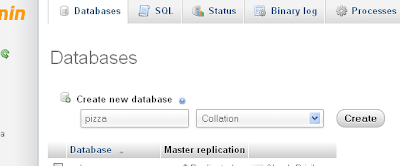What is MySQL?
MySQL is a Relational Database Management System. It can store, search, sort and retrieve data efficiently. You can use it freely under the GPL license. You can check more about MySQL in its official website www.mysql.comWhat do we need?
In this series, we will learn about MySQL by using phpMyAdmin. It will make you more easy to create a database by using phpMyAdmin than command line because it is a GUI(Graphical User Interfaces) system. To use phpMyAdmin you don't need to install anything if you have installed xampp or wamp as mentioned in this post.Type this address "http://localhost/phpmyadmin/" in your browser address bar. You will see like below screenshot.
Creating our Database
Click Databases from the menu.Type in the text box as pizza for the database name and click "Create" button.
You will see your database name in the left menu like below screenshot.
Click your database name. You will see like below screenshot.
Type order in the Name field and type 4 in the Number of columns field like below screenshot. And then click Go button to crate a database table.
Now you need to fill the field name, type etc. like below screenshot.
A database table should have a primary key. So for our order table id field should be the primary key. Select in the Index select box as PRIMARY and set the A_I(AUTO_INCREMENT) check box that will increase automatically our id field number.
Then click Save button.
Now you have created a database table to save your customer order.
PHP and MySQL
It is time to connect the MySQL database by using PHP.Firstly I want to introduce you to the PHP built-in functions that can connect to the MySQL.
mysqli_connect("hostname","username","password","databasename")
Above function will help you to connect the MySQL database. So you need to know the parameter values.
hostname - Hostname running database server. Default is localhsot. For our xampp or wamp is also localhost.
username - Our xampp or wamp default username is root.
password - Our xampp or wamp default password is blank(no password).
databasename - Our database name is pizza.
You need to add below code to our process.php.
<?php
$con = mysqli_connect('localhost','root','','pizza') or die(mysqli_error());
$sql="INSERT INTO `order` (`name`, `address`, `quantity`) VALUES ('$cus_name', '$address', '$quantity')";
mysqli_query($con,$sql) or die(mysqli_error());
?>
First line will connect to our MySQL sever and it will also return a object which represents the connection to a MySQL Server or FALSE if the connection failed. We need to use this return object in other php function.
In second line, I create a variable of SQL statement that will use in the query function. We can write this SQL statement in the query function directly but we do so for the simplicity. This SQL statement will insert the post data from user order to the order table of our pizza database.
The third line will run our SQL Query.
Our process.php file will be like below.
<?php
$title = "Pizza Shop: Order Process";
include('header.php');
include('sidebar.php');
?>
<div id="content">
<?php
if(isset($_POST['submit']))
{
if( $_POST['cus_name'] != '' && $_POST['quantity'] != '' && $_POST['address'] !='' )
{
$cus_name = $_POST['cus_name'];
$quantity = $_POST['quantity'];
$address = $_POST['address'];
$con = mysqli_connect('localhost','root','','pizza') or die(mysqli_error());
$sql="INSERT INTO `order` (`name`, `address`, `quantity`) VALUES ('$cus_name', '$address', '$quantity')";
mysqli_query($con,$sql) or die(mysqli_error());
?>
<p>Thank <?php echo $cus_name; ?> !</p>
<p>You order <?php echo $quantity; ?> pizza.</p>
<?php
$total = $quantity * 10;
?>
<p>It will cost you <?php echo $total; ?> $.</p>
<p>We will send withing 2 hours to <?php echo $address; ?>.</p>
<?php
}
else
{
$_SESSION['error'] = "You need to fill all data";
header("location: index.php");
}
?>
<?php } ?>
</div><!--end of content -->
<?php
include('footer.php');
?>









Superb blog I visit this blog it's extremely marvelous. Interestingly, in this blog content composed plainly and justifiable. The substance of data is exceptionally instructive.
ReplyDeleteoracle fusion financials classroom training
Workday HCM Online Training
Oracle Fusion Financials Online Training
Oracle Fusion HCM Online Training
Oracle Fusion SCM Online Training
Oracle Fusion HCM Classroom Training
Superb blog I visit this blog it's extremely marvelous. Interestingly, in this blog content composed plainly and justifiable. The substance of data is exceptionally instructive.
ReplyDeleteoracle fusion financials classroom training
Workday HCM Online Training
Oracle Fusion Financials Online Training
Oracle Fusion HCM Online Training
Oracle Fusion SCM Online Training
Oracle Fusion HCM Classroom Training
Thanks for provide great informatic and looking beautiful blog
ReplyDeletepython training in bangalore | python online training
aws online training in bangalore | aws online training
artificial intelligence training in bangalore | artificial intelligence online training
machine learning training in bangalore | machine learning online training
data science training in bangalore | data science online training